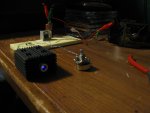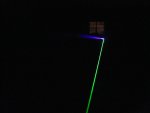Well, I put together a 405nm labby with a diode I bought a while ago off of ebay. I paid a bit too much for this diode (before I had the "brilliant" idea to check the group buys) so I am quite glad I didn't kill this one with heat, too much current (yet..heheh), or by shearing off the pins. This was my first blu-ray/violet/UV 405nm project, and I've been excited about finally getting to see this color displayed in an impressive coherent form. I wasn't disappointed. I used an LM317 driver (in fact, one that was still on the proto-board from another project), and threw in the only resistor I had that was close to what I think is the right spec....a 20ohm. My pot was a 25ohm, so I was kind of worried about having too limited a range of trim for the current, but when I applied power, everything was fine.
Oh, and let me back up. I used an Aixiz module pressed into a Z-bolt heatsink, which had just arrived in the mail a couple days ago. Very nice heatsink by the way, it's inexpensive, and I highly recommend it. I think Dave, ElektroFreak and a few others use this as well. I followed Styropyro's Guide on harvesting diodes and inserting them in the module. I was pretty sure what to do, but his guide was helpful in keeping my eagerness at bay so I wouldn't get in too much of a hurry and ruin the only diode I have right now for 405.
It is a real testament to the knowledge and cooperative spirit of the people on this forum that I was able to so easily make my first 405nm build a successful one. Thanks everyone!

Oh, and let me back up. I used an Aixiz module pressed into a Z-bolt heatsink, which had just arrived in the mail a couple days ago. Very nice heatsink by the way, it's inexpensive, and I highly recommend it. I think Dave, ElektroFreak and a few others use this as well. I followed Styropyro's Guide on harvesting diodes and inserting them in the module. I was pretty sure what to do, but his guide was helpful in keeping my eagerness at bay so I wouldn't get in too much of a hurry and ruin the only diode I have right now for 405.
It is a real testament to the knowledge and cooperative spirit of the people on this forum that I was able to so easily make my first 405nm build a successful one. Thanks everyone!







